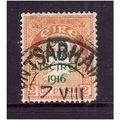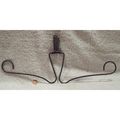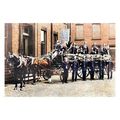Durham Cathedral, Co. Durham - lovely Dixon postcard 1960s
- Condition : Used
- Dispatch : 2 Days
- Brand : None
- ID# : 93647632
- Quantity : 1 item
- Views : 263
- Location : United Kingdom

- Seller : justthebook (+1703)
- Barcode : None
- Start : Sat 23 Feb 2013 20:42:16 (BST)
- Close : Run Until Sold
- Remain : Run Until Sold
More Listings from This Seller view all
Seller's Description
- Postcard
- Picture / Image: Durham Cathedral, Durham
- Publisher: J Arthur Dixon (Durham 146), 1960s
- Postally used: no
- Stamp: n/a
- Postmark(s): n/a
- Sent to: n/a
- Notes / condition:
Check out my !
Please ask if you need any other information and I will do the best I can to answer.
------------------------------------------------
Postage & Packing:
UK (incl. IOM, CI & BFPO): 99p
Europe: £1.60
Rest of world (inc. USA etc): £2.75
No additional charges for more than one postcard. You can buy as many postcards from me as you like and you will just pay the fee above once. (If buying postcards with other things such as books, please contact or wait for invoice before paying).
Payment Methods:
UK - PayPal, Cheque (from UK bank) or postal order
Outside UK: PayPal ONLY (unless otherwise stated) please. NO non-UK currency checks or money orders (sorry).
NOTE: All postcards are sent in brand new stiffened envelopes which I have bought for the task. These are specially made to protect postcards and you may be able to re-use them. In addition there are other costs to sending so the above charge is not just for the stamp!
I will give a full refund if you are not fully satisfied with the postcard.
----------------------------------------------
Text from the free encyclopedia WIKIPEDIA may appear below to give a little background information (internal links may not work) :
*************
The Cathedral Church of Christ, Blessed Mary the Virgin and St Cuthbert of Durham (usually known as Durham Cathedral) is a cathedral in the city of Durham, England, the seat of the Anglican Bishop of Durham. The Bishopric dates from 995, with the present cathedral being founded in AD 1093. The cathedral is regarded as one of the finest examples of Norman architecture and has been designated a UNESCO World Heritage Site along with nearby Durham Castle, which faces it across Palace Green.
The present cathedral replaced the 10th century ""White Church"", built as part of a monastic foundation to house the shrine of Saint Cuthbert of Lindisfarne. The treasures of Durham Cathedral include relics of St Cuthbert, the head of St Oswald of Northumbria and the remains of the Venerable Bede. In addition, its Durham Dean and Chapter Library contains one of the most complete sets of early printed books in England, the pre-Dissolution monastic accounts, and three copies of the Magna Carta.
Durham Cathedral occupies a strategic position on a promontory high above the River Wear. From 1080 until the 19th century the bishopric enjoyed the powers of a Bishop Palatine, having military as well as religious leadership and power. Durham Castle was built as the residence for the Bishop of Durham. The seat of the Bishop of Durham is the fourth most significant in the Church of England hierarchy, and he stands at the right hand of the monarch at coronations. Signposts for the modern day County Durham are subtitled ""Land of the Prince Bishops.""
There are daily Church of England services at the Cathedral, with the Durham Cathedral Choir singing daily except Mondays and when the choir is on holiday. The cathedral is a major tourist attraction within the region, the central tower of 217 feet (66 m) giving views of Durham and the surrounding area.
The see of Durham takes its origins from the Diocese of Lindisfarne, founded by Saint Aidan at the behest of Oswald of Northumbria around AD 635. The see lasted until AD 664, at which point it was translated to York. The see was then reinstated at Lindisfarne in AD 678 by the Archbishop of Canterbury. Among the many saints produced in the community at Lindisfarne Priory, Saint Cuthbert, who was Bishop of Lindisfarne from AD 685 until his death on Farne Island in 687, is central to the development of Durham Cathedral.[1]
After repeated Viking raids, the monks fled Lindisfarne in AD 875, carrying St Cuthbert's relics with them. The diocese of Lindisfarne remained itinerant until 882, when a community was re-established in Chester-le-Street. The see had its seat here until AD 995, when further incursions once again caused the monks to move with the relics. According to local legend, the monks followed two milk maids who were searching for a dun (i.e. brown) cow and were led into a peninsula formed by a loop in the River Wear. At this point Cuthbert's coffin became immovable. This trope of hagiography was offered for a sign that the new shrine should be built here. A more prosaic set of reasons for the selection of the peninsula is its highly defensible position, and that a community established here would enjoy the protection of the Earl of Northumberland, as the bishop at this time, Aldhun, had strong family links with the earls. Nevertheless, the street leading from The Bailey past the Cathedral's eastern towers up to Palace Green is named Dun Cow Lane.
Initially, a very simple temporary structure was built from local timber to house the relics of Cuthbert. The shrine was then transferred to a sturdier, probably wooden, building known as the White Church. This church was itself replaced three years later in 998 by a stone building also known as the White Church, which was complete apart from its tower by 1018. Durham soon became a site of pilgrimage, encouraged by the growing cult of Saint Cuthbert. King Canute was one early pilgrim, granting many privileges and much land to the Durham community. The defendable position, flow of money from pilgrims and power embodied in the church at Durham ensured that a town formed around the cathedral, establishing the early core of the modern city.
type=printed postcards
theme=topographical: british
sub-theme=england
county/ country=northumberland
number of items=single
period=1945 - present
postage condition=unposted
Listing Information
| Listing Type | Gallery Listing |
| Listing ID# | 93647632 |
| Start Time | Sat 23 Feb 2013 20:42:16 (BST) |
| Close Time | Run Until Sold |
| Starting Bid | Fixed Price (no bidding) |
| Item Condition | Used |
| Bids | 0 |
| Views | 263 |
| Dispatch Time | 2 Days |
| Quantity | 1 |
| Location | United Kingdom |
| Auto Extend | No |




 for 1 item(s)
for 1 item(s)

















